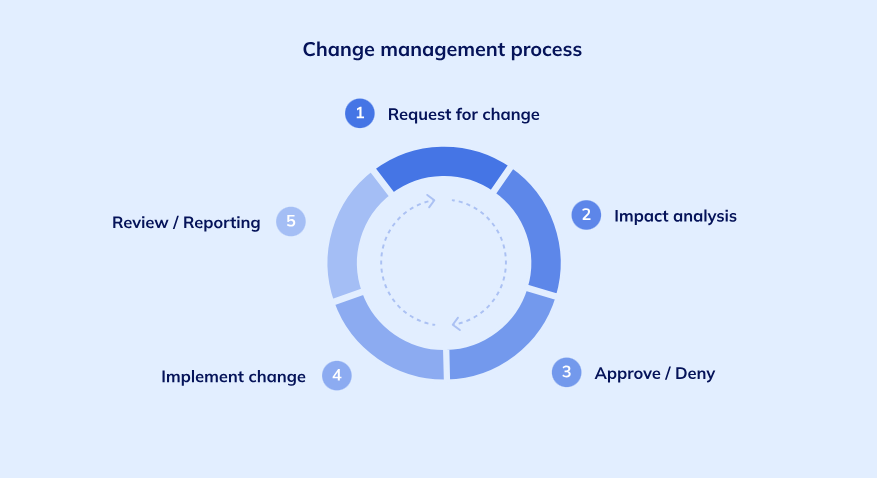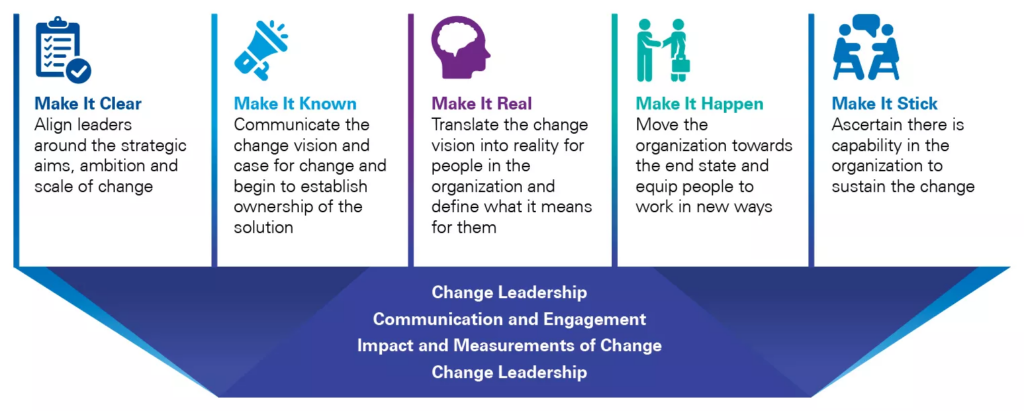The following article was written by Wiise. View the original article here.
Imagine this: it’s the morning of go-live on your new ERP system. For months, your project team has been working hard – researching the right ERP technology, mapping processes, running training sessions and preparing data sets. The new system is ready to go… but only half of the office has turned up for work today.
Why?
Change management is the process of helping the people in your organisation adjust to (usually major) change– neglecting it can jeopardise your entire ERP implementation. In this post, we cover everything you need to know to establish an effective – and lasting – change management process during your ERP implementation.
1. What is change management
Change management is a structured approach to guiding teams to a new state – whether that’s a new IT platform, an organisational restructure or a major compliance change. It involves planning, implementing and managing changes to achieve specific business goals while minimising resistance.

2. Why should I take change management seriously?
Compared with all the other hard deadlines and technical tasks required during an ERP implementation, change management can often be seen as a lesser priority, a one-off or something that can bit slotted in between other more important milestones. Be under no illusion – change management is vital.
Not only does major change happen more frequently than ever before (most organisations have undertaken at least five in the last three years), most employees struggle with it (only 39% feel capable of responding to business changes). This means that not prioritising change management throughout your ERP implementation project is setting up for failure. Your staff won’t understand why a new ERP is necessary, how it benefits them or even how to properly use it – and in some cases, will flat-out refuse to do so.
3. Preparing for change
Communication is a fundamental in change management. Tell your staff what is happening, why and how it will benefit both the wider business and them directly (the ‘what’s in it for me?’ factor) – and tell them:
- as early as possible – so they have time to digest the information, can start asking questions and don’t feel blindsided.
- often – regular communications – across various channels – has been shown to increase the chances of a successful project.
- and with conviction – if your leadership team doesn’t appear to be fully supportive of the ERP implementation, your staff start to doubt it too.
Coming up with a communication plan will help to prevent slipping into bad habits, such as relying too heavily on emails or forgetting to mention key milestones or achievements throughout the project. Remember to use an array of communication channels. While emails are convenient, face-to-face remains the most effective way to communicate with staff during a major change, in particular line-manager briefings and leadership town halls.
Bring staff on the journey by getting them involved in the project. In the early days, asking for input on what they need from an ERP or current frustrations that could be fixed is a great way to position the change as a solution, not a problem and help them feel valued.

Source: KPMG
4. Planning for change
Early on in your ERP project you’ll have identified your objectives – and even have a defined scope of works (SoW), outlining exactly what is being delivered and how. But despite meticulous ERP project planning, many organisations fail to plan for the impact that a new ERP system will have on their organisation.
To help plan for the change, it’s a good idea to pre-empt potential roadblocks – for example:
- Key stakeholders – Who are they and what can we do to win their support and buy-in for the project?
- Staff – What concerns are they likely to have? How will we enable them to share feedback/concerns? How will we keep them informed/positive about the implementation? How will we reward/incentivise them for successfully embracing/using the new ERP system?
- Customers – How will this impact our customers (both positively and negatively)? How can we keep them informed or lessen any inconvenience?
- KPIs – How will we know if the ERP implementation was a success? What measurements will we put in place?
5. Getting staff up to speed
The technology that staff have to use on a daily basis to get their jobs done can have a massive impact on their satisfaction and stress levels (91% are frustrated by workplace tech). Think of training as your best strategy for ensuring employees adopt your new ERP system – staff who are fully comfortable with your new ERP system will have less anxiety, be more productive and feel more productive.
To ensure that your ERP system training is comprehensive and suits all learning styles:
- Use a ‘train the trainer’ approach – a nominated user from each team can be trained, who then, in turn, can train other members of the team. This can make training feel less overwhelming and also help with fitting in around staff availability and schedules.
- Record training sessions – this is another way to help staff to fit training around busy schedules, but also enables them to re-watch certain more complex training sessions and learn at their own pace.
- Make cheat sheets – these are an excellent way to break information down into manageable, scannable chunks for faster learning. Cheat sheets are also a first step towards creating a standard operating procedure (SOP) – a written reference for how a particular process or task should be completed. Not only are SOPs a useful resource to keep for future reference or new staff onboarding, they can ensure consistency throughout the organisation and minimise errors or compliance risks
- Offer a training ‘sandbox’ – everyone learns differently. Some staff learn by doing a task themselves, others by watching someone else. A sandbox allows for both types of learners to practice their learning, enabling staff to log in,click around, familiarise themselves with the look and feel of the new technology, as well as testing what they can and can’t do. Practice makes perfect!
- Encourage users to ask questions – staff should be able to draw relevant knowledge from each training session that’s directly applicable to the tasks they perform within the business. Tying training sessions to specific day-to-day scenarios and explaining how it fits to a specific role is a great way to ensure all processes are covered. The goal is to build as much confidence in the new system as possible!
6. Making it stick
As your ERP project ramps up, so should your change management efforts. Go-live is the critical point of any ERP implementation project and, once the new system is live, it’s important to keep staff engaged and positive about the changes (especially when experiencing teething issues).
To make sure staff don’t avoid using the new system or fall back into old ways of working:
- Lead by example – all senior staff should be using the system from go-live onwards, no exceptions.
- Use influencers – influential people in your organisation can act as advocates for the new system (10 digital superstars can drive new ways of working in around 100 others).
- Reward early adopters – single-out and reward staff who have made good progress in adopting the new system as an example to others.
- Set KPIs – make using the new ERP system part of your employees’ job descriptions and include it in team KPIs.
- Share successes – celebrate the wins! If certain jobs are now significantly easier or faster than before, share this with the rest of the organisation. Deliver on your initial ‘what’s in it for me?’ promise to employees. Share business objectives achieved and acknowledge the individual contributions made in making the go-live a success.
7. Did it pay off?
The point of all this hard work, planning and communicating is to end up with a significant improvement for your business, your teams and your customers. Taking time to review and compare your new versus old ERP system and its impact on the business is the only way to fully understand whether the change was a success. Being able to prove that it has paid off will help to convince any staff who are still struggling to accept the new ways of working – as well as paving the way for future changes.
- Review your KPIs – look at the key KPIs that were set at the outset of the project and assess whether these were met. While KPIs should be based on your specific business goals, common success metrics include inventory turnover, production or processing times, revenue, error rates or missed/delayed deliveries.
- Ask for employee feedback – this can be as simple as a feedback survey, hosting an ‘Ask Me Anything’ session, or a question posed in one-to-one meetings with line-managers. Ultimately, you’re trying to assess whether the new system is helping employees to do their jobs more quickly and easily than previously.
- Room for improvement – perhaps this was the first major IT project your organisation has tackled, or perhaps it’s one of many. Either way, getting your project team and ERP implementation partner together to review how the project was managed will help you to identify where things could have been done differently to achieve better outcomes in future projects.
Changing for the better
In the ‘people, process, platform’ framework, it’s almost always the ‘people’ that are neglected in major business changes (and an ERP implementation is definitely a major business change). But your ‘people’ are both the main reason for implementing better technology (to help productivity) and the key to its success (70% of IT projects fail because the ‘human factor’ has been overlooked).
The reality is that most of your staff will need help adapting to the major changes that come with a new ERP system. Prioritising change management throughout your ERP implementation will ensure that all aspects of your business – your process, platform and people – are aligned and ready for growth.
Ready to start your ERP implementation? Get in touch with our team of ERP experts on (07) 5479 1877 or email enquiries@momentumss.com.au for a no-obligation chat.
